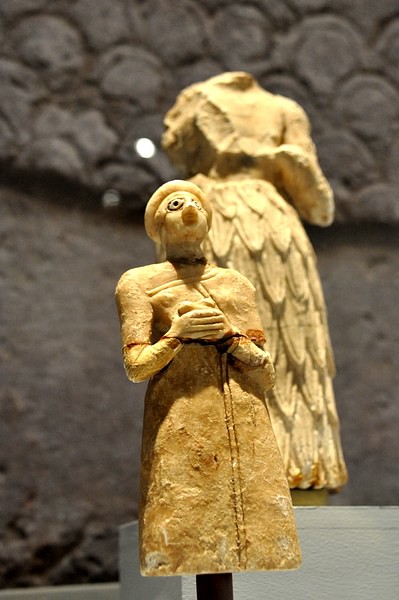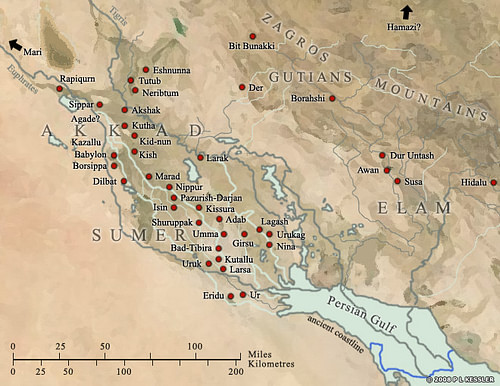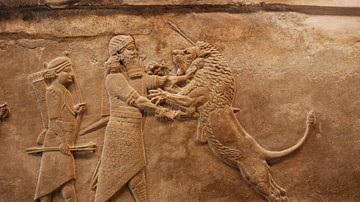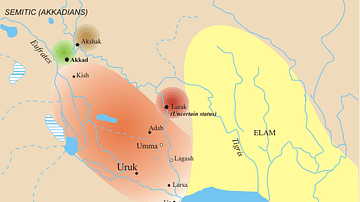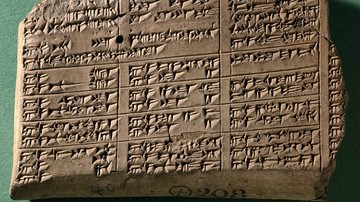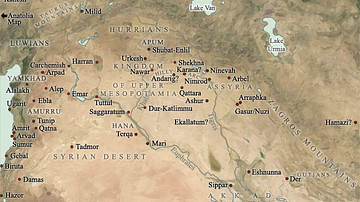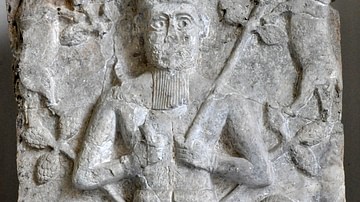Imagine something that has never been thought of before. If one holds a book in one's hands, one can imagine an e-book, a large-print book, a picture book, all kinds of books. But how does one imagine a book in a world where even the concept of a `book' does not exist?
Imagine a day without time. People live in time and time directs the course of people's days. We wake up at a certain hour, go to work or school at another, eat at regular times, and go to sleep based upon the revolutions of the clock. Once, however, there existed a time without time. How does one imagine something which does not exist?
Both time and writing, and many other aspects of our daily lives, were invented by the Sumerians of ancient Mesopotamia over 5,000 years ago. Before the Sumerians, a day began with the sunrise and ended with the sunset. People went to work from when the sun was positioned at a certain height in the morning sky and returned to their homes when it set. It was the Sumerians who divided the day from the night by time, by increments of sixty-second minutes and sixty-minute hours which made up twelve hours of night and the twelve hours of the day.
In the biblical Book of Genesis, chapter 1, it states that God divided the night from the day and saw that it was good. If one accepts God's role in creating day and night then the Sumerians finished the job and, if one does not, it was not God who divided night and day – it was the Sumerians.
Inventing the Future
Sumer was the region of southern Mesopotamia c. 5000/4500-1750 BCE corresponding to modern-day Iraq and Kuwait. The land was inhabited prior to 4500 BCE by people of unknown origin who archaeologists have designated the Ubaid people (after the site of al-Ubaid where excavations first uncovered their existence). The Ubaid are considered the first agents of civilization in the region in that they had rudimentary technological knowledge as evidenced by tools and clay artifacts they left behind.
They did not, however, possess the same kind of skill and ingenuity as the Sumerians who came after them. The Sumerians are responsible for inventing many of the aspects of modern-day life that people so often take for granted. In his work, History Begins at Sumer, Samuel Noah Kramer lists 39 `firsts' in human civilization and culture that originated at Sumer. His list includes:
The First Schools, The First Case of `Apple Polishing', The First Case of Juvenile Delinquency, The First `War of Nerves', The First Bicameral Congress, The First Historian, The First Case of Tax Reduction, The First `Moses', The First Legal Precedent, The First Pharmacopoeia, The First `Farmer's Almanac', The First Experiment in Shade-Tree Gardening, Man's First Cosmogony and Cosmology, The First Moral Ideals, The First `Job', The First Proverbs and Sayings, The First Animal Fables, The First Literary Debates, The First Biblical Parallels, The First `Noah', The First Tale of Resurrection, The First `St. George', The First Case of Literary Borrowing, Man's First Heroic Age, The First Love Song, The First Library Catalogue, Man's First Golden Age, The First `Sick' Society, The First Liturgic Laments, The First Messiahs, The First Long-Distance Champion, The First Literary Imagery, The First Sex Symbolism, The First Mater Dolorosa, The First Lullaby, The First Literary Portrait, The First Elegies, Labor's First Victory, The First Aquarium.
In addition to these accomplishments, of course, are the rudimentary invention of time, a system of numbers, the 360 degree circle, geometry, the first wheeled vehicles, children's toys, writing, writing implements, harnessing the wind, the domestication of animals, agricultural developments such as irrigation, medical advances, dentistry, architectural developments, and urbanization.
The Discovery of Sumer
The Sumerians also seem to have invented the concept of siege warfare and, perhaps, even the `scorched earth' tactic used effectively in military engagements ever since. What this means to an individual in the present is that, every day, one is making use of some aspect of Sumerian invention. The clock which tells one when to get out of bed, the car or bus which transports one to work or school, the newspaper or textbook one reads from, and the concept of an end to the work or school day all originated with the Sumerians. Kramer notes that:
One remarkable fact is that only a century ago nothing was known even of the existence of these Sumerians in ancient days. The archaeologists and scholars who, some hundred years ago, began excavating in that part of the Middle East known as Mesopotamia were looking not for Sumerians but for Assyrians and Babylonians. On these peoples and their civilizations they had considerable information from Greek and Hebrew sources, but of Sumer and the Sumerians they had no inkling. There was no recognizable trace either of the land or of its people in the entire literature available to the modern scholar. The very name Sumer had been erased from the mind and memory of man for more than two thousand years. Yet today the Sumerians are one of the best-known peoples of the ancient Near East. We know what they looked like from their own statues and steles scattered throughout several of the more important museums…Moreover, Sumerian clay tablets by the tens of thousands (literally), inscribed with their business, legal, and administrative documents, crown the collections of these same museums, giving us much information about the social structure and administrative organization of the ancient Sumerians. (History Begins at Sumer, xx)
The discovery of Sumer was, more or less, an accident. The archaeologists and scholars Kramer refers to were drawn to Mesopotamia in search of biblical correlations. The Bible made cities like Babylon and Nineveh infamous, and so the Babylonians and Assyrians were well known to 19th century scholars. They began their excavations in Mesopotamia in an attempt to confirm the historicity of biblical stories such as The Great Flood or the Tower of Babel. The only reference to Sumer in the Bible is to `the Land of Shinar' (Genesis 10:10 and elsewhere), which people interpreted to most likely mean the land surrounding Babylon, until the Assyriologist Jules Oppert (1825-1905 CE) identified the biblical reference with the region of southern Mesopotamia known as Sumer and, further, asserted that cuneiform writing was Sumerian in origin.
This was an astounding feat comparable to someone today asserting that Plato's Atlantis is modern Bermuda and being able to prove it and, even more so, in that there was no comparable `Bermuda'. No one knew Sumer had ever existed. Oppert was by no means the first European explorer interested in Mesopotamia or cuneiform writing. Jean Chardin (1643-1713 CE) explored the region and wrote about his discoveries in his book Travels in Persia, published in 1686 CE. Chardin was the first European to claim that the strange marks found on clay tablets and architectural ornamentation were not mere decoration but, in fact, an advanced writing system.
It was not until the mid-19th century, however, that scholars and archaeologists such as William Kennet Loftus (1820-1858 CE), George Smith (1840-1876 CE), Robert Koldewey (1855-1925 CE), and Henry Creswicke Rawlinson (1810-1895 CE) began to bring to light the civilization of ancient Sumer and the many accomplishments of the Sumerian people.
Sumerian Literature and the Bible
Prior to the discovery and decipherment of cuneiform script, human beings understood the origins of certain aspects of life in quite a different way. Writing was thought to have originated in Phoenicia, time-telling in China, schools in Greece, and the first love song in the biblical book of The Song of Solomon. The Old Testament of the Bible was considered the oldest book in the world until this was disproven by the German Assyriologist Friedrich Delitzsch (1850-1922 CE) who, building upon the work of men like George Smith, showed that the Sumerians had written stories concerning a fall of man and a great flood before the narratives of Genesis were ever set down. The scholar Paul Kriwaczek writes,
Thus it was established that long before Genesis was committed to writing, the ancient Mesopotamians had themselves told the story of a universal flood sent by divine decree to destroy humanity. Soon other texts were discovered that gave similar accounts in several different languages – Sumerian, Old Akkadian, Babylonian – and in several different versions. In the oldest, found on a tablet from the city of Nippur, dated to around 1800 BCE and written in Sumerian, Noah's role is taken by a King of Shuruppak called Ziudsura or Ziusudra, meaning `he Saw Life”, because he was awarded immortality by the gods. In another, written in the 1600s BCE in the Akkadian language, the protagonist is called Atrahasis, meaning `Extremely Wise'. (69)
Conclusion
The Sumerians, therefore, can also be credited with the earliest form of one of the most potent myths of western civilization: The Great Flood. In attempting to prove the historical truth of the Bible, the archaeologists and scholars of the 19th century CE revealed that the biblical narratives held as absolute divine truths were later interpretations of the literature of the Sumerians.
As noted, however, it is not simply in the field of religious studies that the discovery of Sumer changed the way people understand the world in the present. In their many inventions and innovations, the Sumerians lay the groundwork for so many advancements in the daily lives of human beings that, today, it is impossible to imagine life without these things. Somehow, the people of Sumer were able to imagine things which had never existed on earth before and, in expressing their imaginations, invented the future.
